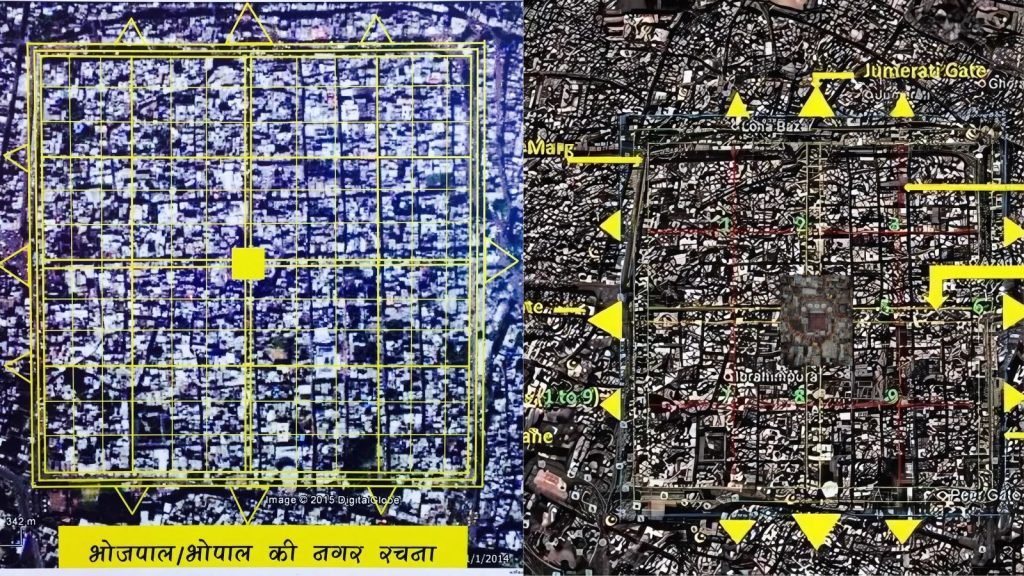Raja Bhoj’s Smart City (1010 AD)

A City Ahead of Its Time
When we think of Smart Cities, we imagine modern technology, sustainable infrastructure, and advanced urban planning. But what if we told you that over 1,000 years ago, a visionary king laid the foundation of what could be considered India’s first smart city?
Welcome to the story of Raja Bhoj’s Bhojpal (modern-day Bhopal), a city designed with a futuristic approach long before urban planning became a formal discipline. From Asia’s largest man-made lake to self-sufficient settlements and sustainable water management, Raja Bhoj’s vision was nothing short of extraordinary.
Let’s take a deep dive into the urban genius of Raja Bhoj and how his 1,000-year-old city-building strategy still influences modern Bhopal.
Raja Bhoj (1010 – 1055 AD) was a legendary ruler of the Paramara dynasty and one of India’s greatest kings. He ruled over Malwa (present-day Madhya Pradesh) from Dhar and was known for his military prowess, scholarship, and architectural brilliance.
He was a polymath who excelled in engineering, architecture, medicine, astronomy, and Sanskrit literature.
He authored over 20 books on various subjects, including urban planning and water management.
His reign saw the construction of temples, stepwells, irrigation systems, and educational institutions, many of which stand strong today.
But his most remarkable contribution? The foundation of Bhojpal, a city built to last.
The Birth of Bhojpal – The Original Smart City
A City Built Around Water – The Great Lake of Bhojpur
Raja Bhoj’s most ambitious project was the construction of a massive artificial lake, covering 422 sq. km—the largest man-made lake in Asia.
According to historical records, Bhoj suffered from a chronic skin disease that could only be cured by the waters of a lake that collected water from 365 rivers. Determined to build such a water body, he chose a low-lying area between two hills (Bhojpur & Kolar) and dammed the Betwa River, creating the “Bhoj Sagar” lake.
Why was this lake special?
Flood Control & Water Security: It acted as a natural reservoir, preventing floods and storing water for year-round use.
Irrigation & Agriculture: It supported farming communities, making the region self-sufficient.
Climate Regulation: The lake cooled the surrounding area, making Bhojpal more habitable.
Even today, what remains of the lake is known as the Upper Lake of Bhopal, designated as a Ramsar Wetland Site for its ecological significance.
Urban Planning: The Science Behind Bhojpal’s Layout
Unlike many ancient cities that grew without structure, Bhojpal was a meticulously planned settlement.
The city was designed in a grid pattern, similar to today’s modern cities.
Wider roads and open spaces were created to ensure easy movement and airflow.
Distinct zones were marked for residences, markets, temples, and administrative centers.
One of the most impressive feats? The city’s drainage system!
Raja Bhoj incorporated an advanced drainage and sewage disposal system, ensuring clean water supply and sanitation—something many modern cities still struggle with!
Bhojeshwar Temple – An Architectural Marvel
While planning his capital, Raja Bhoj also envisioned one of the grandest Shiva temples ever built—the Bhojeshwar Temple at Bhojpur.
This massive, incomplete temple is still one of the largest monolithic temple structures in India, featuring a 7.5 ft tall Shivalinga carved from a single rock!
Why is Bhojeshwar Temple special?
It is unfinished, yet its architectural mastery has puzzled historians for centuries.
It follows Vastu Shastra & Indian engineering principles in its design.
The massive stone slabs used in construction are a testament to Raja Bhoj’s mastery over engineering.
Bhojeshwar Temple is now being considered for UNESCO World Heritage status, further cementing Raja Bhoj’s legacy.
Education & Knowledge Centers – The Wisdom of Bhoj
Raja Bhoj was not just a king; he was a scholar and educator. Under his rule, Bhojpal became a center of learning where scholars from across India came to study science, philosophy, mathematics, and Sanskrit literature.
He founded the Bhoj Shala in Dhar, an ancient university dedicated to Sanskrit and literary studies.
His book, Samarangana Sutradhara, is one of the earliest texts on architecture, town planning, and even mechanical automation (robots!).
Imagine—1,000 years ago, Raja Bhoj was already discussing concepts that modern engineers are studying today!
Bhojpal to Bhopal – The Evolution of a Smart City
Over time, Bhojpal underwent many changes:
Mughal rulers reduced the lake’s size, but its remnants still form today’s Upper Lake.
Dost Mohammad Khan, an Afghan ruler, officially established modern Bhopal in 1707.
The Begums of Bhopal modernized the city, adding palaces, mosques, and markets.
Post-independence, Bhopal emerged as a major educational and industrial center.
Today, as Bhopal grows into a Smart City under India’s urban renewal mission, it carries forward Raja Bhoj’s vision of sustainability, water conservation, and structured development.
Why Raja Bhoj’s Vision Matters Today
Raja Bhoj’s principles of city planning are still relevant in modern urban development.
Water Management: His reservoir-based system can inspire today’s sustainable water conservation projects.
Zoning & Infrastructure: The concept of structured urban zones aligns with modern smart city blueprints.
Sustainable Architecture: The eco-friendly materials used in Bhojeshwar Temple could be adapted for modern green buildings.
Education & Research: His legacy of knowledge centers can be revived by developing Bhopal into a hub of learning.
Raja Bhoj didn’t just build a city—he built a blueprint for the future.
The First Smart City of India
Bhojpal, envisioned by Raja Bhoj in 1010 AD, was more advanced than many medieval cities of its time. With its water management, structured urban planning, architectural grandeur, and focus on education, it was a true Smart City—1,000 years ahead of its time!
As Bhopal grows into a modern metropolis, it must embrace and honor Raja Bhoj’s visionary planning by incorporating sustainable urban designs, conservation efforts, and knowledge-driven progress.
Now is the time to rediscover and redefine Bhojpal as the “Kamaal Ka Bhopal” of the future!
Let us celebrate Raja Bhoj’s legacy as a master planner, architect, and visionary leader!